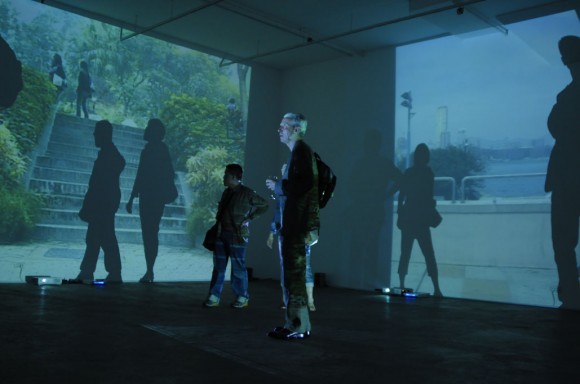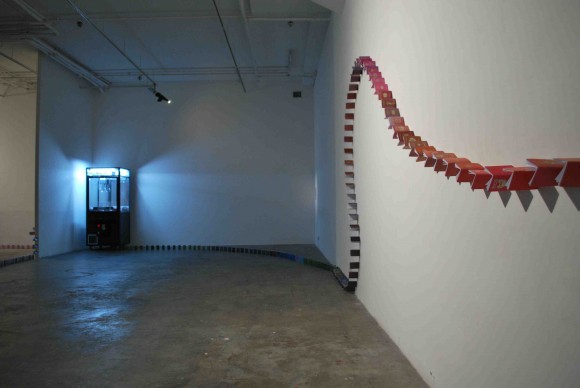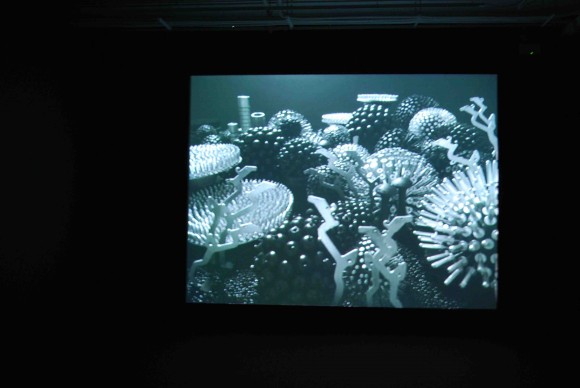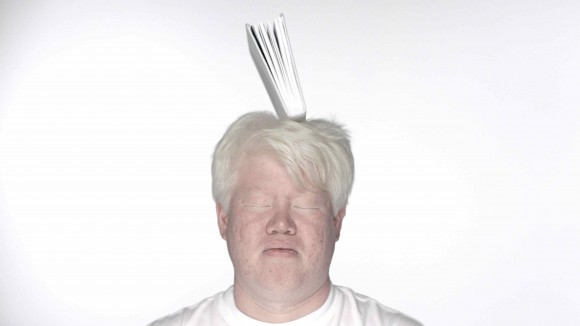


Opening Night. Louie Cordero
From February – May 2009 Ossage Gallery, Kwun Tong, Hong Kong is presenting Some Rooms, an exhibition that is a slice of contemporary art from Southeast Asia. 5 Curators were paired with two artists (selected by Ossage) each from Thailand, Singapore, Malaysia, Indonesia and, (strangely in my mind) Hong Kong. I had the opportunity to work as one of the curators, and managed to learn an incredible amount about curating, about creating meaning, about categorising artists by nationality and the challenges of representation.

Poklong Anading, “Ocular”, 2009 four screen video projection
Here is a brief breakdown of the artists and curators.
Thailand: Independent Curator, Kate Chattiya working with Artists: Wit Pimkanchanapong and Pratchaya Phinthong
Singapore: Independent Curator, June Yap working with Artists: Ho Tzu Nyen and Donna Ong
Phillipines, Independent Curator, Isabel Ching working with Artists: Louie Cordero and Poklong Anading
Malaysia and Indonesia: Independent Curator, Eva McGovern working with artists Tintin Wulia (Indonesia) and Vincent Leong (Malaysia)
Hong Kong: Curator and Director of Para/Site Hong Kong, Alavaro Fominaya working with artists Silas Fong and Doris Wong
Each artist was given a room to present their work, which normally consisted of one piece each, although Louie Cordero from the Philippines exhibited a large scale installation of sculpture and painting. The gallery in Kwun Tong is a COLOSSAL concrete, warehouse, spectacle that is so common these days. Warehouses are still, apparently, very cool and the ideal space for contemporary art. I agree when it comes to installation and film (although it is not the definitive context of course), the cavernous, raw and exposed nature of the space fed the works with an energy that was formidable and electric.
One of the main premise of the show, was the curator as collaborator, or the collaborative process between artists and curators in the production of work and exhibitions. Which was interesting, except that this process was not really highlighted/documented for exhibition goers to see, the only chance to reveal this to audiences was at a panel discussion with all the curators, and new Director of Exhibitions at Ossage, Eugene Tan the day after the opening. My situation was very interesting. As the ‘Malaysian’ curator I was asked to work with one artist from Malaysia and Indonesia. Now, why did Malaysia and Indonesia only have one artist each? Why was there no Indonesian curator? Ironic given the country’s large number of artists and curators as well as the sophistication of the art scene there. Also methods of communication were quite challenging in some respects for this project. Vincent and I are both in the same city, so there were many studio trips and conversations about the direction he wanted to take his new work. However, Tintin Wulia, the Indonesian artist selected, is based in Australia and was unable to travel for the installation/opening so we talked over Skype, email, sms, and sent each other various large media files. We installed the work (a very complex piece with hundreds of miniature replica passports that had to be adhered to the gallery floor and walls in curving trails, along with a claw vending machine) without her present. She to date, as far as I know, has not been able to see the show. And we have still not met! In this instance, how a curator represents an absent artist who is not there to intervene, comment, question, was interesting and daunting for me since Tintin’s work is meticulous and extremely detailed in production and concept.
 Vincent Leong, “Doolby Surround Sound”, Megaphone and projection, 2009
Vincent Leong, “Doolby Surround Sound”, Megaphone and projection, 2009
~
 Tintin Wulia, “Lure”, 2009, Miniature replica passports, standard size replica passports, and claw vending machine
Tintin Wulia, “Lure”, 2009, Miniature replica passports, standard size replica passports, and claw vending machine
What really came across though more effectively was the second premise, a slice of contemporary art production in Southeast Asia. And this show had a voice, or competing voices because there was lots and lots of high octane sound bouncing off the cement walls and floors.
 Donna Ong, “Landscape Portraits (A Beautiful Place Closeby”, video projection 2009
Donna Ong, “Landscape Portraits (A Beautiful Place Closeby”, video projection 2009
~
 Ho Tzu Nyen, NEWTON, single channel video projection (2009)
Ho Tzu Nyen, NEWTON, single channel video projection (2009)
It would have been better in my mind if there had been some referencing to the process of collaboration even if only for the curators themselves in a walk around the show together with the gallery staff as well (we need to dialogue with each other you know) so that we could share our experiences. Although we certainly talked about our processes during drinks and dinners, somehow I felt like being in the space together would have really benefited us and the artists we were working with.
 Wit Pimkanchanapong
Wit Pimkanchanapong
~
 Pratchaya Phintong
Pratchaya Phintong
~
 Doris Wong, Wong Wai Wheel Art Space 2009 Coming Shows by Wong Wai-yin Doris, 2009
Doris Wong, Wong Wai Wheel Art Space 2009 Coming Shows by Wong Wai-yin Doris, 2009
~
 Silas Fong, “In Some Second”, dual-screen video installation, 2009
Silas Fong, “In Some Second”, dual-screen video installation, 2009
Ok so I want to describe each work a bit, and a few more things, but that will make this post go on and on. So I will try and post some descriptions if people are interested in the comments section….
(EM)
Sorry, the comment form is closed at this time.
Ok guys here is some more info on the artists that I was working with.
Tintin Wulia
‘Lure’ is a spatial installation using handmade miniature passports, handmade real-size passports, and a claw vending machine. A long line of colourful miniature passports are laid along the wall and floors of the gallery space similar to Hansel and Gretel’s trail of breadcrumbs leading back home. This guides the viewers to a claw vending machine, a reference to the witch’s candy house in Hansel and Gretel’s story.
In the machine’s transparent container, instead of a prizes, the audience sees a collection of colourful handmade passports from all the current nation- states in the world. The audience can play the machine by inserting a one dollar coin into the machine’s slot to activate the claw and try their luck at winning a passport.
In Lure, passports are like candies: people want as much as they can have, and it is attainable for just a small fee. You still have to be either lucky or highly skilled, but neither as a boat person nor as a skilled migrant, nor even as a native to the land – rather, as a player controlling the claw, instead.
Stemming from the artist’s ongoing project (Re)Collection of Togetherness, in where she collects and remake passports of all the current nation-states in the world, Lure examines the relationship between chance and citizenship in a re-imagined world.
Excerpts taken from artist statement.
Vincent Leong
‘Doolby Surround Sound’ recreates the cinematic qualities of sophisticated audio systems through low tech means. 6 megaphones are suspended from the ceiling and emit a 10 second reproduction of the iconic Dolby ‘surround sound’ commercial heard before the beginning of feature films. Simultaneously, a blue screen animation is projected onto one of the gallery walls mimicking the visuals that accompany the Dolby sequence. Doolby’s pirated version breaks down 6 chords from the over all sound which is then repetitively played back creating a cacophonous tonal experience. Functioning between the realms of parody and experimentation, Doolby Surround Sound reveals Leong’s continuing fascination with new media and the authenticity of personal experience in an increasingly marketed and repackaged world.
Ok just to let you know that these are taken from the captions I put together for the show!!
Strange how Singapore got two entries and Malaysia and Indonesia had to split between you. As for HK in SEA, I guess its the host’s privilege of self-inclusion.
Well done on the semi-autonomous installation of Tintin’s piece. It can’t have been easy. But maybe it makes such works more clearly the product of a composite social entity rather than an individual auteur. Just like films aren’t simply just a director’s realisation in spite of the glory and power bestowed on that role.
The show looks impressive. I’m sure all of the documentation between you and Tin Tin could form a whole other art work in itself as it adds a layer of complexity to it. Perhaps that would be one way of showing part of the process between artist and curator.
Wish that I could have been there……..
Okay I promised Eva to post the captions for the 2 artists I curated for this show, so here they go!
Poklong Anading
The beginnings of “Ocular” is a set of photographs steadily accumulated over 11 years of the artist’s deceased mother. Taken during the period of time she had worked in Hong Kong as a domestic helper, the photographs were sent back home to her children in the Philippines as keepsakes. Reconstructing his mother’s unknown life from the photographic fragments, Anading retraces her steps in Hong Kong by following the clues in the photographs to identify and film the locations shown. He allows the terms of the photographs to determine the framing of the scenes, shooting them with a hand-held video camera. However, the private pain and ultimately nostalgic view of the fundamental absence of the referent and the impossibility of capturing its existence through recording technologies are circumvented. Rather, the artist attempts to activate the interrelations between the audience, artist and landscape through the operation of the gaze. Anading links the presences of the onlookers’ shadows in the gallery to issues of authentic representation and experience in photographic and video representations. The activating of inter-subjective associations through a consciousness of the spatial landscape of the gallery also arouses questions regarding the sense of place – one’s relation or a community’s relation to a space.
Here’s my caption for the 2nd Filipino artist:-
Louie Cordero
Cordero makes no apology for bad taste. He deliberately employs it, and in fact, positively relishes nurturing the kitsch aesthetic into being to achieve incongruent juxtapositions that alternately fascinate and repel. Visually spectacular, Cordero’s art consists of appropriating and recycling the already recycled, appropriated imagery prevalent in the city of his birth – Manila. In choice of subject matter, any lulling sentimental clichés is avoided in favour of the bizarre, the nightmarish and the idiosyncratic. Here, Cordero presents a cultish setting marked by adolescent antics, pulp horror flavor and popular imagery. There is an ambiguous commingling of modern-day spirituality with capitalistic consumerism within the white-cube gallery space. Black Zeal displays the face of a Filipino movie stuntman and Lead Brother is a self-portrait of the artist at 6 or 7 years of age. Central to Cordero’s presentation is a towering sculpture ‘vandalized’ with chewed green gum. A tribute to a popular green-coloured comic character popular in the Philippines in the 1980s who feeds on female virgin hearts, this monstrous creature is disorientating in its contexts and caught between tradition and modernity. The paintings are a homage to the fast-disappearing commercial art of billboard painting. Through their disfiguring, Cordero attempts to create a new aesthetic in order to revitalize them and allow for their continuation in today’s world.
The 2 artists I was allocated by Osage to curate were from the Philippines – Poklong Anading and Louie Cordero. I’m Singaporean though :) Thank goodness I was able to coincide this project with a much needed holiday, flying to Manila for a period before the show so I could understand both their practices abit better and discuss about the show face-to-face, as well as take a vacation in the Philippines outside of Manila. From what I remember, Eugene Tan (Osage’s Exhibition Director) explains that the artists and the curators should not have collaborated in any extensive way before in the past, the artists chosen are some of the best or most exciting young artists in Southeast Asia, and the curators – Eugene has had some contact with them before.
There is also a component of Some Rooms that opened at Osage Shanghai 1 week after Some Rooms at Osage Kwun Tong (Hong Kong) opened. The Shanghai show involved other artists: 1 from HK (Lee Kit) and 3 from mainland China (Li Fuchun, Qin Siyuan, Danny Wu), and was curated by Fu Xiaodong. The artists in HK’s and Shanghai’s Some Rooms turned out to be mostly male, and the curators mostly female. Including Shanghai’s Some Rooms, 5 out of 6 curators are female, whereas 12 out of 14 artists are male.
Preparing for the show did cause me to question curatorial process, and I hope the artists were also able to participate in this questioning.
Here is a caption of the exhibition label text that I wrote about Silas Fong:
“His latest work takes us into the realm of experience. The artist is not just preoccupied with the production of the images, but this time he applies the idea of circulation to his videoinstallation. Armed with a video camera inside a bus, he shot from the left side of the bus, thus filming a footage that shows us the life on the other side of the window. Passersby are invited to react to this filming as the artist reuses some of his tactics. The resulting video is exhibited in a real life size two channel projection”
Here is a selection from the text on Doris Wong:
“Through her development as artist she has evolved from the study of public space and architecture – “Home-moving Furniture”, 2002 and “Mobile Lake”, 2003 to the History of Art, and finally the Art System as a structure, which it does connect with her previous interests. Going back to where we started, with Twelve Posters there is a sense of infiltrating the art world, like a self prophecy of the times to come”
As a curatorial experience it was a puzzling but an interesting one. Having the artists “assigned” and surrender the selection process, which is the basis of conceptual curatorial development was intriguing and strange, and as a different way of working it proved challenging.
Congratulations to all the other curators. Pitty not to be able to know them more!
HO Tzu Nyen (Singapore)
NEWTON
2009
Video
4 min 16 secs
A shift from Ho’s usual narrative works, NEWTON presents a minimal exposition on the act of inspiration. A play on Issac Newton’s discovery of gravity, the figure in the work undergoes a similar weighty experience that however circles back upon itself in an exploration of determinism and freewill.
Donna ONG (Singapore)
(Sound by Y.C. Teo)
Landscape Portraits (A Beautiful Place Close By)
2009
Single-channel video (Film sets created from hardware and sewing materials; sound design by Y.C. Teo, created from materials used in the sets)
6 min
Ong’s narrative installations hinting on the fantastic and the imaginary take on a new dimension in this work, where landscapes created through meticulous effort using common materials, are traversed through video. Playing with viewers expectations, she explores shifting scale and perspectives incorporating sounds created by sound artist, Y.C. Teo, with the same materials into her unconventional landscape.
About the curatorial collaboration…
Coming from Singapore I think both Eugene and i were familiar with the work of Donna and Tzu Nyen. Myself i have however worked with Tzu Nyen before and have written on works of both the artists.
Personally the process of collaboration is a rather tricky one, and the desire to collaborate may not coincide with the right time or circumstances to collaborate. For both Donna and Tzu Nyen, both artists had projects they were looking to do, and thus the exhibition was a means to realise them – and perhaps the process of realisation may be seen as a sort of collaboration as well, if not in terms of content, then in terms of activating, encouraging, allowing for certain desires to manifest. Creative collaboration requires a bit more effort and affinity of desires of the parties involved, as well as time. It also works better with a more personal relationship that goes deeper than curatorial administration and curiosity.
Sorry Eva for late such a late post, here are 2 artists I worked with from Thailand.
Wit Pimkarnchanapong and his two artworks discussed about the contemporary idea on Avatar from cyberspace and also an argument on representation of what we have been received.
The work entitled ‘Apple Apple’ are presented on display shelf. One is presented like a screensaver and another is in a form of paper-model fixed with servo motor, and both are synchronized by custom-made software in order to move them in the same direction at the same time. Rather than touching or tasting the apple, the work aims to arouse the viewer’s visual experience. The perfect imitation of apple’s image is an endeavor to insist the illusion of representation that the idea of real and concrete object may not be necessary anymore. The moving technique of both physical and digital apple does not only present the use of technological method in making a representation, but also raise an open-ended question among us that which apple is derived as the very first original idea.
Meanwhile, another work presented the idea of ‘avatar’; a created character and appearance in cyberspace culture has been introduced in this work. A display of different forms of fruit including pare, apple, banana, mangosteen, orange, and starfruit, which also become the title of the work. However, the form and skin of these fruits are presented in a false appearance from the original, for example, banana form is covered by mangosteen skin, and apple form is under a banana skin. The work depicts the idea of avatar from simulation games like The Sims, and Internet forum where we are offered the same human form and structure, but we are able to choose our skin color, clothes, and hairstyle, in order to point out that virtual reality becomes more important in our daily lives today. In cyberspace, it might be another place to escape from reality and enjoy our new world. We are free to create someone else, and this finally challenges the idea of fixed identity and form.
Apart from Wit, Pratchaya Phonthong is another Thai artist who always work differently under the context and concept. This time he experimented his idea challenging the value of representation. Unlike Wit, Pratchaya doesn’t work with object in terms of presenting his view onwards representation. However, this work called ‘Demonstration’ consists of an empty room with only a note informing the audience to contact the gallery attendant to see the actual work. What the audience will experience from this “demonstration” is not only to see a piece and start a dialogue about the work, but the actual incident related to the object will be frozen and the question among the viewer’s perception will be raised. Conceptually, the work aims to discuss about function and influence of mass media, as well as to challenge people’s perception towards the information we get, the source of those information, and the “real” value of things, since everything can be constructed, filtered and presented by those who have the power and opportunity to do so.